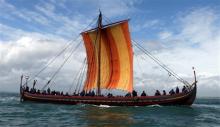Much of Viking folklore alludes to a mysterious “Sun Stone”, a navigational tool that historians have not been able to locate at any of their archeological digs. A recent development, however, hypothesizes that Vikings’ “Sun Stone” may actually be a calcite crystal housed in a special instrument used for locating the sun’s position. The calcite works by depolarizing the sun’s light on a cloudy day. Even when the sky is overcast, the sun’s light sends off polarized concentric circles of light. On a clear day you can see these circular patterns looking toward the sun. On a cloudy day the calcite can refract the polarized light to show you the relative position of those rings.
According to Wired.com, the calcite does this by a property known as “birefringence”. The light passing through the crystal is actually broken along two paths, and the brightness of the two paths of light relative to one another will show how “slanted” the angle of the sunlight hitting the crystal is. By adjusting the crystal until both paths of light are equally bright, the medieval Viking captain could allegedly keep his ship on course. Wherever the instrument housing the calcite crystal is pointing when both paths are equally bright, that’s the direction o the sun.
To test this theory Guy Ropars and a team of researchers at the University of Rennes, built a sun stone by taking a chunk of calcite crystal from the spars in Iceland and housing it in a wooden box-like instrument. The box is designed with a hole to direct light form the sky directly onto the crystal which then in turn projects the two paths of light onto a surface. Standing on the shore and calibrating the sun stone from a known position, Ropars and his team set sail to test their sun stone for a fully over-cast day. The result? Ropars found that navigating by this Sun Stone was over 99% correct.
It’s an ingenious solution to open-sea navigation, but Ropars cautioned that no actual device like this has ever been discovered at any archeological dig. It simply uses the tools and resources available to Vikings at that time to construct a possible instrument that would have fit this ancient Viking “Sun Stone”.
